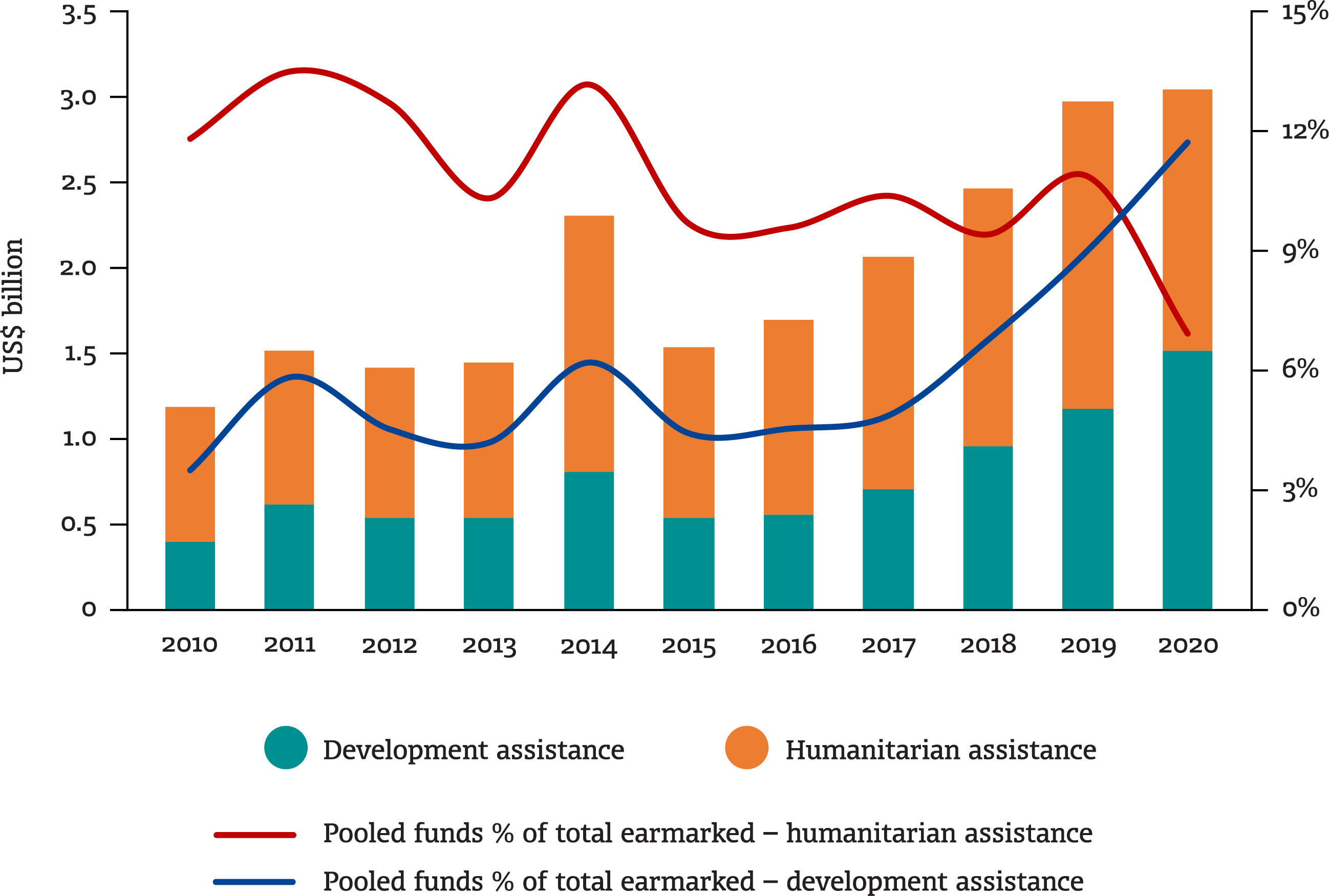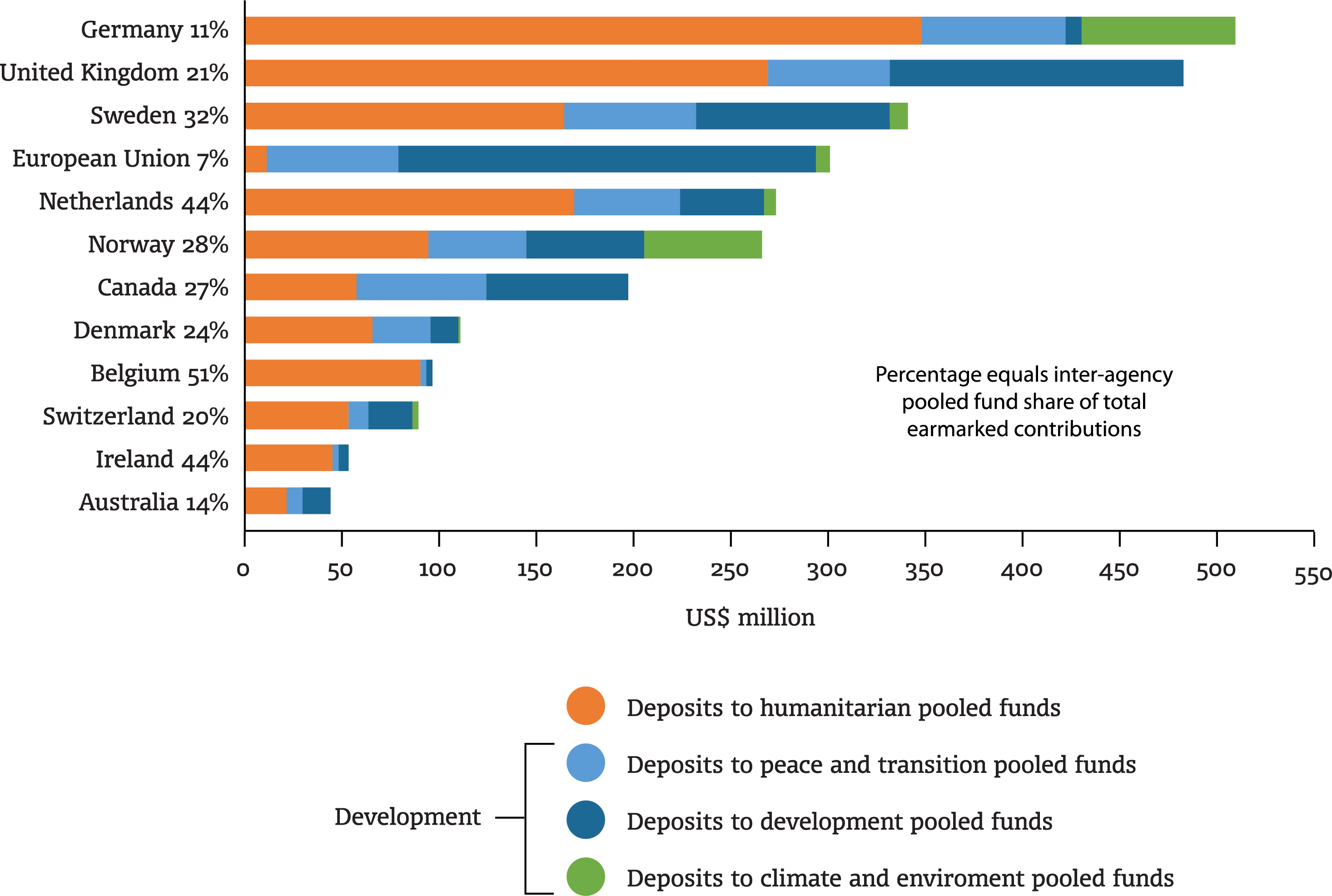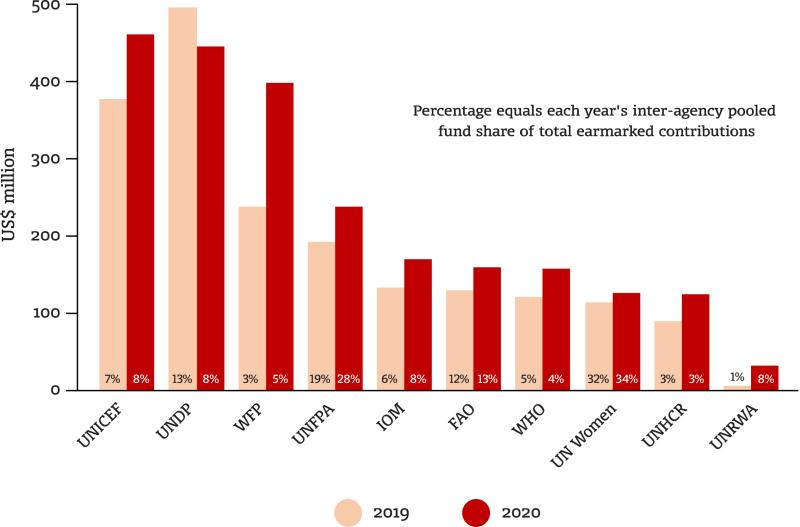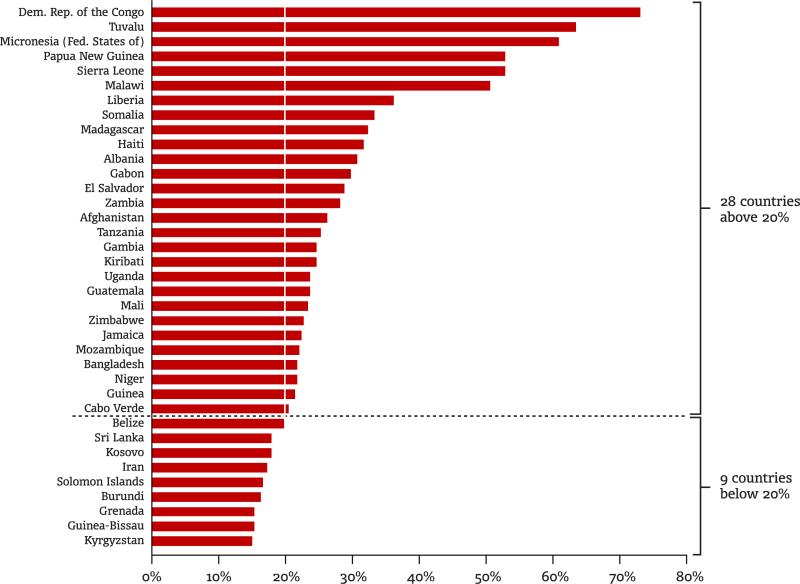
Pooled fundingUN pooled funding trends
The following section includes data and analyses adapted from the report "Financing the UN Development System", which is annually prepared by the UN Multi-Partner Trust Fund Office and Dag Hammarskjöld Foundation. |
|---|
Inter-agency pooled funds are recognised as an instrument to support UN reform and promote collaboration and efficient coordination across the UNDS. They can be described as ‘core-like’ financing to the UN system as a whole, providing the equivalent of the core funding given to its constituent entities. Gathering together stakeholders and pooling funds for the purposes of a thematic or country strategy allows for greater flexibility and coordination in achieving SDG implementation. This section examines inter-agency pooled funds as a preferred UN financing instrument, as highlighted in the Funding Compact.
Earmarking through inter-agency pooled funds, as well as single-agency thematic funds, plays out very differently from earmarking to a specific project or programme. Inter-agency pooled funds can be global or regional, focusing on a thematic or geographical area, or based at a country level, supporting implementation of a UNSDCF or Joint Programme. The following figures show who is contributing to inter-agency pooled funds; what types of funds these are; which UN entities are making use of them; and the countries in which such funds are being deployed.
Figure 1 shows that inter-agency pooled funds are on an upward trend, especially since the introduction of the SDGs in 2015. In 2020, total contributions passed US$ 3 billion for the first time, with the proportion of development-related funds growing to 50%. Humanitarian funds have represented the larger share, constituting around 60–70% of inter-agency pooled funds over the preceding decade. Development-related funds have more than tripled between 2010 and 2020, from US$ 0.4 billion to US$ 1.5 billion, while humanitarian-related funds have nearly doubled over the same period, from US$ 0.8 billion to US$ 1.5 billion.
Development-related inter-agency pooled funds have increased as a share of total earmarked development funding to 11.7% in 2020. This may be explained by the introduction of the Funding Compact in 2019, when a target – which arguably could have been more ambitious – was agreed that Member States should provide at least 10% of earmarked development funding to inter-agency pooled funds by 2023. The large increase in overall earmarked funding for humanitarian activities has resulted in a sharp decrease in the percentage of funding to inter-agency pooled funds, from 10.8 % in 2019 to 6.9% in 2020.
Between 2010 and 2020, inter-agency pooled funds for development assistance more than tripled |
Figure 1. Deposits to UN inter-agency pooled funds 2010–2020 (US$ billion)

Who are the main contributors to pooled funds?
Figure 2 lists the top 12 contributors to inter-agency pooled funds in 2020. The top contributors remained the same as in 2019, accounting for US$ 2.8 billion, or 92%, of the total resources provided to these funds. All of these donors, aside from the EU, directed more than 10% of their earmarked funding to inter-agency pooled funds – in the cases of Belgium, Ireland and Netherlands, inter-agency pooled funds accounted for almost half their earmarked funding to the UN.
Figure 2. Deposits to UN inter-agency pooled funds from the top 12 contributors, 2020 (US$ million)

In Figure 2 funds are divided between humanitarian funds and the three themes falling under the category of development funds: peace and transition; climate and environment; and other development funds. As the urgent need for investments in combatting climate change has grown, so too have climate-related inter-agency pooled funds, from a humble US$ 43 million in 2015 to US$ 175 million in 2020, which was double the 2019 figure. Germany and Norway are the largest contributors to climate and environment funds, including the Central African Forest Initiative, which saw its funding more than double in 2020 compared to 2019. Donors have, depending on their strategic priorities, chosen to support a varied combination of inter-agency pooled funds. Germany, the United Kingdom and the Netherlands all have a strong focus on humanitarian funds, with substantial contributions to CERF and a number of country-based humanitarian funds. The EU, by contrast, mainly contributes to development-related inter-agency pooled funds, with large contributions made to the Spotlight Initiative for the elimination of violence against women and girls.
|
|
Climate and environment funds have grown from US$ 43 million 2015 to US$ 175 million 2020 |
Figure 3 further analyses the extent to which Member States channel their earmarked funding through inter-agency pooled funds. In 2020, 23 countries provided 10% or more of their earmarked funding to inter-agency pooled funds, compared to 22 in 2019. Programme countries invest in country inter-agency pooled funds to enhance implementation of their UNSDCFs and accelerate SDG attainment. Papua New Guinea (PNG), one of the new countries on the list, invested 21% of its earmarked funding in inter-agency pooled funds due to its contributions to the PNG UN Country Fund. Uzbekistan is another example, having contributed 26% of its earmarked funding to the Aral Sea Region Fund.
Programme countries are investing in pooled funds domestically to advance Cooperation Frameworks and accelerate the achievement of the SDGs. |
Figure 3. Countries contributing over 10% of their total earmarked funding to the UN through inter-agency pooled funds, 2020

Which are the main implementing UN entities?
Turning to those at the receiving end of inter-agency pooled funds, Figure 4 shows the ten implementing UN entities that received the highest revenue through inter-agency pooled funds in 2019 and 2020. Aside from UNDP, all these entities increased their total resource flow from inter-agency pooled funds in 2020. The most remarkable change can be seen in WFP, which received a large increase in funding through CERF related to its role in the COVID-19 pandemic response. UNICEF also saw notable growth in revenue from inter-agency pooled funds connected to funding through CERF and the UN COVID-19 Response and Recovery Fund. Figure 21 also highlights the importance of revenue from inter-agency pooled funds for specific UN entities, indicating the level of flexibility they have in using their earmarked funding. More flexible funding from inter-agency pooled funds constitutes around a third of total earmarked funding to UNFPA and UN Women, with this share having increased in 2020 compared to 2019.
Figure 4. Top ten UN entities that receive the highest revenue through inter-agency pooled funds, 2019–2020 (US$ million)

In which countries do inter-agency pooled funds contribute to development results?
The level of inter-agency pooled funds provided for implementation of programme countries’ development plans gives an indication of the access enjoyed by these countries to earmarked funding that can be used strategically to support, among other things, UNSDCFs. Figure 5 illustrates the UN programme countries that received 15% or more of their development-related earmarked funding through inter-agency pooled funds. In 2020, 37 countries reached this threshold, with a total of 58 countries receiving more than 10% of their earmarked development funding through inter-agency pooled funds, compared to 28 in 2018 and 40 in 2019. In the case of the Democratic Republic of the Congo (DRC), 75% of the earmarked development funding it received in 2020 came mainly from two inter-agency pooled funds, for the purposes of halting deforestation and forest degradation in the region.
Figure 5. Countries where 15% or more of earmarked development-related expenditure comes from UN inter-agency pooled funds, 2020 (37 countries)

